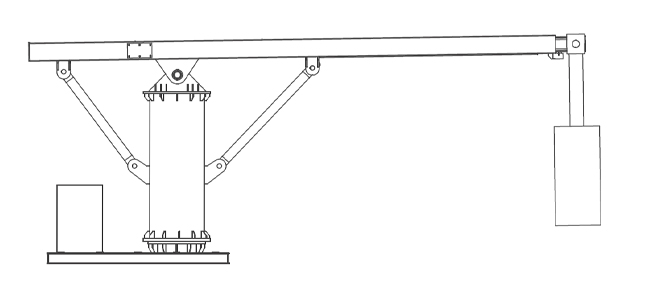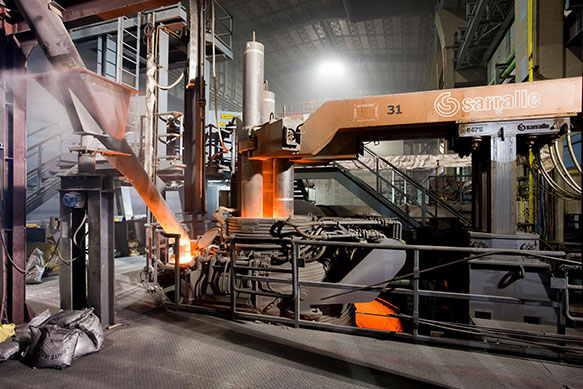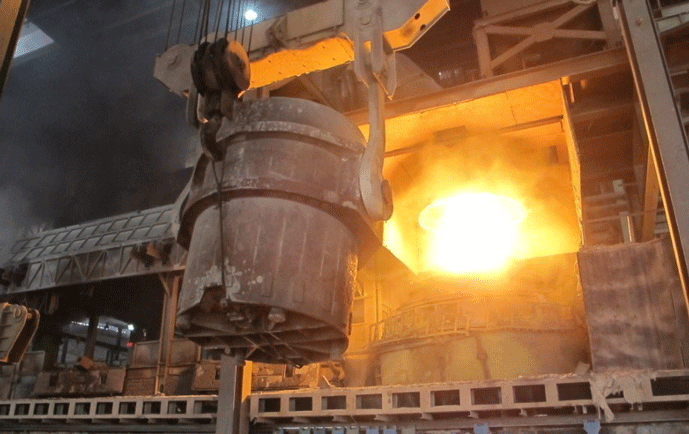Steel Melt Shop Equipment
Lining Vibrator
In induction furnaces working face of the main crucible is lined with a suitable ramming mass. Furnace performance
is directly related to the lining performance.
Well-stabilized lining results in smooth working of furnace, optimum output and better metallurgical control. The
lining practice best suited to particular foundry will depend upon the furnace capacity and design, metal being
melted and output etc.
2/3/5 ARM LINING VIBRATOR:
2/3/5 arm lining vibrators are used
for side lining preparation, consist
2/3/5 vibrator cylinder and one air
divider at center of the equipment.
It automatically rotates inside the
former due to the angle of impact.
It will take 1-2 hours for the full
operation.
BOTTOM LINING VIBRATOR:
Bottom Vibrator Unit ramming
plate is equipped with one
pneumatic vibrator.
Dry refractory is rammed in
about 50 min. in one operation,
achieving perfect compaction
and absolutely even and leveled
bottom.
REQUIREMENT OF A
PROPER LINING:
Thermal characteristics:
It should with stand the stresses developed by the thermal cycle in
operation. It should be chemically insert to the metal being melted:
chemical inertness to molten metal can be achieved by using acid lining
for acid slag & basic lining for basic slag. It should have enough
structural strength to withstand operating conditions.
The thickness of refractory lining must be such as to ensure good
electrical
efficiency and thick enough to counter the risk of unexpected failure and
major damage to the coil. It should have high erosion resistance.

COMPARISON MANUAL LINING V/S LINING USING VIBRATOR:
| SR.NO. | MANUAL LINING | LINING USING LINING VIBRATOR |
|---|---|---|
| 1 | Erratic and shorter lining life | Consistent and enhanced lining life |
| 2 | Unpredictable production | Predictable and increased total output tonnage |
| 3 | Lining thickness is not uniform around the former | Lining thickness is absolutely uniform around the former |
| 4 | Refractory material in the tapered Section of the former is not completely deaerated leading to non-uniform erosion of lining and problems like elephant foot & leakage. | Material in the tapered section of the former is completely dense achieving max. & uniform compaction. Thus erosion is uniform in the tapered section eliminating any possibility of elephant foot & leakage due to weak lining. |
Sintering Heater
Sintering Heater consist of Steel structure of heater fabricated withMS & Steel material suitable for Induction Furnace. The heater Having Automatic Temperature Controller with Thermocouple.
The Sintering Heater consists of Kanthalmake Heating Element of Ni Cr Base Heating coil, Ceramic Insulation material. The heater having ceramic blanket 128Gr and Ceramic Bobbins & SS Studs 310Gr.

Hydralic Pusher
Hydraulic pusher system feature an innovative, rugged design to help minimize time-consuming tasks on the melt deck, improve furnace utilization and maintain the integrity of Initiated metal castings. We believe that Just to sell capital good is not important, the difference highlights itself when you serving your customers throughout.

Foundry Slag Skimmer System
Foundry requires a device to assist
operators in removing slag from a scrap
melt furnace. The process involves
skimming the slag, removing it through a
door and dumping into a bucket as well as
manipulating the scrap in the furnace to
complete the melt process.
These operations were done manually
with the operator standing next to the
open furnace door utilizing a long handle
ladle. The same process typically applies
to melting steel, iron, copper, aluminum
scrap and other metals.
Benefit of SLAG SKIMMER:
 Reducing Metal Loss: Molten metal stays in the furnace insteadof being removed with the slag with conventional slag.
Reducing Metal Loss: Molten metal stays in the furnace insteadof being removed with the slag with conventional slag.
 Improving Operator Safety and Comfort: The operator does not have to perform heavy manual work while exposed to extreme heat.
Improving Operator Safety and Comfort: The operator does not have to perform heavy manual work while exposed to extreme heat.
 Minimizing the Cost of Expendables: Heavy duty steel blades last longer than rods and paddles.
Minimizing the Cost of Expendables: Heavy duty steel blades last longer than rods and paddles.
 Operating Efficiently: The rate of slag removal in pounds per minute is higher than that of a manual skimming operation.
Operating Efficiently: The rate of slag removal in pounds per minute is higher than that of a manual skimming operation.
 Reducing Radiation Loss: The furnace lid is opened for a shorter period of time while the slagging operation takes place. Lowering and raising is controlled by the crane.
Reducing Radiation Loss: The furnace lid is opened for a shorter period of time while the slagging operation takes place. Lowering and raising is controlled by the crane.

Ladle Furnace
A ladle furnace is composed by a three-electrode electric system, operating AC mode; working into a three-phase electrical circuit, usually placed on the vertices of an equilateral triangle in around the furnace.

Electric Arc Furnace
Electric Arc Furnace (EAF) is a steel making furnace, in which steel scrap is heated and melted by heat of electric arcs striking between the furnace electrodes and the metal bath.
Two kinds of electric current may be used in Electric Arc Furnaces: direct (DC) and alternating (AC).
Three-phase AC Electric Arc Furnaces with graphite electrodes are commonly used in steel making.

Resistance Furnace
Resistance furnaces are heating installations that use the heat generated by Joule effect in appropriate heating elements (resistors) located on the walls of the furnace chamber, and transmitted to the workpiece to be heated mainly by radiation and convection. The electrical energy transformed into heat in the resistors is used in part to raise the temperature of the charge and in part to heat the walls of the chamber and to compensate for the furnace heat losses. After a description of the different constructive types of furnaces (batch, continuous, for low, medium or high temperature, with protective atmosphere or in vacuum), heating cycle, criteria and materials for wall design and test methods of this type of furnace are analyzed. In the final paragraphs, we will describe the different types of resistors, characteristics of materials used for their construction and design criteria of resistors for classical radiation or convection furnaces. At the end, furnaces with high specific power resistors are briefly discussed, making also reference to the energy balance of this type of furnaces.

Vacuum Degassing
Vacuum degassing is a technique of removing dissolved gas from a liquid solution by lowering the pressure inside a vessel containing the solution. Vacuum degassing is often utilized in:
1.Water treatment
2.Laboratory testing
3.Soil purification
Vacuum degassing is the only way to make certain grades of steel that are particularly useful in the automotive, aerospace and railroad industries.
